Table of contents
The green, flat oval pumpkin seeds are the peeled seeds of the pumpkin ( Cucurbita ssp.) and are popular as a healthy snack. Pumpkin seeds often come from the Styrian oil pumpkin ( Cucurbita pepo styriaca), as these seeds lack the enclosing shell. Pumpkin seeds are availableraw and roasted - but raw is much healthier.
Use in the kitchen:
Roasted pumpkin seeds are a crunchy snack for in-between meals and a real treat in salads, soups or muesli. Dried or roasted pumpkin seeds are also used with rice, pasta and especially vegetables - see our recipe for celery linguini (raw, dried pumpkin seeds) or for watermelon jicama salad with pumpkin seeds, mint and chili (roasted pumpkin seeds).
Mixed with sunflower seeds, linseed and other seeds and nuts, pumpkin seeds can be put together to create your own seed mixtures depending on your taste and use.
Peeled pumpkin seeds are known in Mexico and Latin America as "pepitas", from the Mexican Spanish "pepita de calabaza" (little seed of squash). In Mexican cuisine, they are also often found as an ingredient in traditional dishes. In Spain, they are called "pipián" and in Greece, lightly roasted, salted and peeled seeds are popular as "πασατέμπος" (from the Italian passatempo = hobby, pastime). In North America, they are marinated after roasting and also nibbled as a snack. 1 In any case, raw (= unroasted) pumpkin seeds would be better for your health.
Pumpkin seed oil is also pressed from pumpkin seeds. Styrian pumpkin seed oil is traditionally obtained from the roasted seeds of the Styrian oil pumpkin ( Cucurbita pepo var. styriaca), but there is also pumpkin seed oil made fromunroasted seeds.
Vegan recipe for rocket salad with roasted pumpkin seeds:
With this recipe you can conjure up a vegan rocket salad with avocado, tomatoes and roasted pumpkin seeds for 1 person - or a side dish for 2 people.
Preparation: Roast 2 tablespoons of pumpkin seeds gently and without fat or use some from your own stock (see "Your own preparation" below) and set aside. In a bowl, season 1 tablespoon of cold-pressed oil (e.g. rapeseed oil) and 1 tablespoon of dark balsamic vinegar with freshly groundpepper and a little salt (alternatively, you can leave out the salt and oil and add lemon juice to the sauce instead). Finely chop 1 spring onion and add. Dice the flesh of a medium-sized, ripe avocado together with a large tomato and add as well. Wash and prepare 125 g of rocket and mix with the remaining ingredients in the bowl. Sprinkle the salad with the pumpkin seeds, serve and enjoy.
Vegan recipes with pumpkin seeds can be found under the note: " Recipes that have the most of this ingredient ".
| Not only vegans or vegetarians should read this: Vegans often eat unhealthily. Avoidable nutritional errors. |
Shopping - where to buy?
Roasted pumpkin seeds can be found in shops in various qualities. Unfortunately, the roasting temperatures can no longer be determined, but when buying products, make sure that the seeds are not roasted too darkly. When shopping, prefer organic pumpkin seeds. The typical dark green, flat oval and rather large pumpkin seeds of the Styrian oil pumpkin stand out with their intense aromatic taste. However, there are also smaller, rounder seeds available to buy.
Supermarket chains such as Coop, Migros, Denner, Volg, Spar, Aldi, Lidl, Rewe, Edeka, Hofer etc. offer roasted pumpkin seeds, if at all. They are often salted, sometimes even flavored with wasabi, curry or sweetened with honey, caramelized sugar or chocolate. Please note, however, that these additives often lead to excessive consumption.
Making your own roasted pumpkin seeds:
You can make roasted pumpkin seeds yourself from practically any pumpkin. The seeds of the Hokkaido pumpkin and the butternut squash are ideal.
First, remove the pulp from the seeds. This is best done in a bowl of water, where you separate the fibers from the seeds. Another option is to place the seeds in strong salt water to loosen the pulp that is still attached. All remaining fiber residues can be removed with a kitchen towel. Then dry the seeds with a towel and leave them to dry either in the sun, in a slightly open oven at a maximum (!) of 40 °C, or in a dehydrator. After drying, the seeds can be removed from the shell. It is recommended that you carefully work the dried seeds with a rolling pin on a smooth surface. Applying light pressure will break the shell. You can now break the cut surfaces apart with both thumbnails, a knife, or scissors and free the seeds from the shell.
You can also boil the white kernels briefly in water. They are then very easy to peel.
To roast the pumpkin seeds, you can heat them briefly in a coated pan without any additional oil. Unfortunately, you can't keep an eye on the temperature as well here. In the oven, it takes a little longer, but you can regulate the temperature more precisely. Many recipes recommend 160-180 °C. However, since the smoke point of the oil used is 120 °C, we strongly recommend roasting below this. Leave the pumpkin seeds in the oven for around 30-40 minutes; turning them occasionally will prevent one-sided roasting.
For a more special taste, you can mix the pumpkin seeds with a littlepepper, paprika powder, thyme, garlic (and possibly 1-2 tablespoons of oil or a little salt). Spread them on the baking tray lined with baking paper and roast gently in the preheated oven.
Storage:
Roasted pumpkin seeds are best stored in a tightly sealed container (glass or bag) in a dry place protected from light. They will then last for several months. Musty smelling seeds should be disposed of immediately.
Ingredients - nutritional value - calories:
Roasted pumpkin seeds without salt have a very high energy content of 574 kcal/100g. The calories come mainly from fat (49 g/100g) and protein (30 g/100g).
Although roasted pumpkin seeds contain a lot of unsaturated fatty acids, the ratio between omega-6 and omega-3 fatty acids is very unfavorable (> 170:1, Ø 182:1). In contrast, linseed has an extremely healthy ratio of 1:4 - see ingredient tables below 2 and link in the box above. It is extremely rare for a food without fortification to even achieve the opposite ratio of ALA, i.e. have more omega-3 in the form of ALA than omega-6 (LA).
According to the Federal Office of Public Health ( FOPH), the average value should not exceed 5:1 (LA:ALA). Erb-Müesli, for example, can correct this. If you enter the "sorting by health values" option in the ingredients list, you can select healthy ingredients or those that would compensate for a deficiency. The same applies to recipes, e.g. with sorting by LA:ALA ratio. You can see the importance of this aspect in the link to olive oil, where we explain it in detail.
Pumpkin seeds contain a wide variety of antioxidant-active plant substances that capture reactive free radicals in our body and are responsible for a large part of the typical pumpkin seed effects. These include phenolic acids, lignans (a phytoestrogen), phytosterols and carotenoids (e.g. beta-carotene, lutein).
There are also other substances in pumpkin seeds: with 1174 mg/100g they are very rich in phosphorus, similar to unpeeled hemp seeds (1,650 mg/100g). 550 mg of magnesium (per 100 g of pumpkin seeds) cover 147% of the daily requirement, similar values are found in wheat bran. Only 4.5 mg/100g of the trace element manganese cover around 225% of the average daily requirement of a woman. The manganese content in oat flakes is comparable. Zinc and iron are also well represented among the trace elements. 1
Caution: If roasted improperly, valuable ingredients can be lost and even trans fats can be created.
You can find all the ingredients, the coverage of the daily requirement and comparison values with other ingredients in our nutrient tables. In the article Nutrients explained you will get a detailed insight into the topic.
Health aspects - effects:
The protein in pumpkin seeds also provides a lot of lysine, an amino acid that is only found in small quantities in most types of grain. Pumpkin seeds can therefore be an excellent supplement to grain protein.
Pumpkin seeds also contain a large amount of the amino acid tryptophan (100 g correspond to 230% of the recommended daily dose) 3. Many protein-rich animal foods do not provide as much tryptophan as pumpkin seeds. The body uses tryptophan to produce the hormone serotonin, and from this the hormone melatonin.
Serotonin has a positive effect on our mood and melatonin ensures good sleep. There are studies that show a positive effect on sleep problems through regular consumption of pumpkin seeds. 4
The values of the roasted pumpkin seeds are only slightly lower in the range mentioned here than those of the raw seeds (see ingredient tables).
Dangers - intolerances - side effects:
Unfortunately, pumpkin seeds have a very poor ratio between the two essential fatty acids linoleic acid (LA, pro-inflammatory) and alpha-linolenic acid (ALA, anti-inflammatory). 2 You would have to compensate with tree nuts or macadamia nuts.
The phytic acid contained in pumpkin seeds is not only harmful. In addition to binding minerals, phytic acid also has positive properties. Read this article : Briefly soaking seeds helps to reduce the amount of phytic acid.
If you prefer unsalted pumpkin seeds, there is less risk of overdose.
Use as a medicinal plant:
Pumpkin seeds and medicines made from them are traditionally used to strengthen bladder function in cases of bladder weakness, especially in old age and in women. 5 These substances in pumpkin seeds are also effective in cases of irritable bladder and problems with urination caused by benign prostate enlargement. 6
Taking pumpkin seeds does not normalize the size of the prostate, it only alleviates the symptoms. For this reason, prostate hyperplasia should be subject to regular medical check-ups.
In particular, lignans, estrogen-like secondary plant substances, appear to be particularly important for the positive effects of pumpkin seeds. Recent research shows that lignans are responsible for regulating our hormone levels. They play a regulatory role in bladder function. 5,6
Lignans are found in high concentrations in the aqueous extract of pumpkin seeds. The recommended daily dose is about ten grams, which corresponds to 2-3 tablespoons of pumpkin seeds per day. 7
Pumpkin seeds - or even better pumpkin seed oil - are also said to help against intestinal worms. 7
Occurrence - Origin:
Pumpkins are grown in locations ranging from hot, dry areas to cool cloud forests. However, most species grow in hot lowland areas with distinct rainy and dry seasons. Pumpkins require a lot of sunlight and are sensitive to frost.
Cultivation - Harvest:
Information on pumpkin cultivation can be found under the ingredient pumpkin, raw.
General information:
The original domesticated form of the pumpkin, Cucurbita pepo, dates back to the time of the inhabitants of the caves of Guilá Naquitz in the province of Oaxaca (not Oxaca), Mexico (ca. 8000 BC). Other pumpkin finds come from Tikal (Guatemala, 2000 BC to 850 AD) and from Peru (3000 BC). The musk pumpkin was domesticated in Central America and the giant pumpkin in South America. In the 19th century, cultivation is documented in India, Java, Angola and Japan. 8
It is assumed that people originally only used the nutritious seeds, as these are free of bitter substances - while all wild forms have bitter fruits. By selecting non-bitter forms, humans have made it possible to use them as vegetables.
Today, five types of pumpkin are cultivated: Cucurbita argyrosperma, fig leaf pumpkin ( Cucurbita ficifolia), giant pumpkin ( Cucurbita maxima), musk pumpkin ( Cucurbita moschata) and garden pumpkin ( Cucurbita pepo). Pumpkins also thrive in the sand of coastal dunes or even on waterlogged lowland or gravel soils, but they require a lot of sunlight. 8
In English, roasted pumpkin seeds are known as roasted pumpkin seeds.
Literature - Sources:
Bibliography - 8 Sources (Link to the evidence)
| 1. | Wikipedia Englisch Pumpkin seed. |
| 2. | USDA United States Department of Agriculture. |
| 3. | Kasper H, Burghardt W. Ernährungsmedizin und Diätetik. 12. Auflage. München: Urban & Fischer Verlag. 2014. |
| 4. | Hudson C et al. Protein source tryptophan versus pharmaceutical grade tryptophan as an efficacious treatment for chronic insomnia. Nutr Neurosci. April 2005. |
| 5. | Yanagisawa E. et al. Study of Effectiveness of Mixed Processed Food Containing Cucurbita Pepo Seed Extract and Soybean Seed Extract on Stress Urinary Incontinence in Women. J Med Pharm Sci 2003; 14(3). |
| 6. | Terado T. et al. Clinical Study of mixed processed foods containing pumpkin seed extract and soybean germ extract on pollakiuria in night in elderly men. J Med Pharm Sci 2004; 52(4). |
| 7. | Pahlow M. Das grosse Buch der Heilpflanzen. Hamburg: Nikol Verlag. 2013. |
| 8. | Wikipedia Kürbisse. |

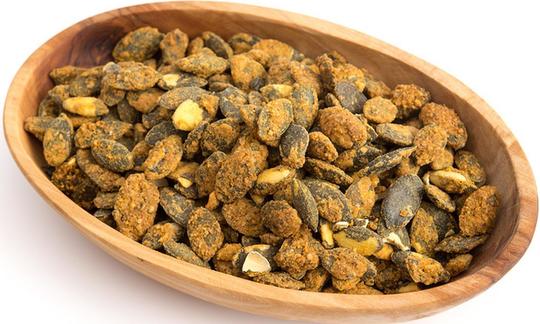

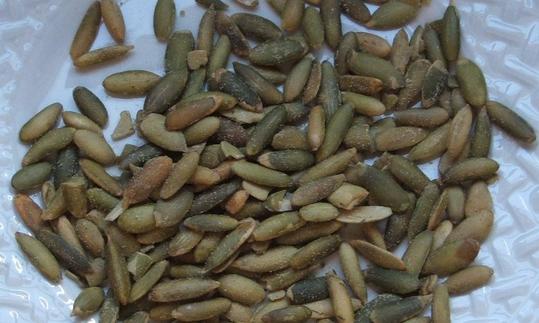

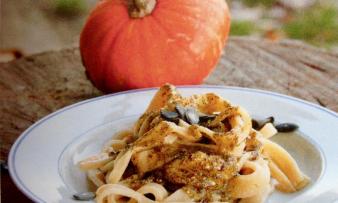
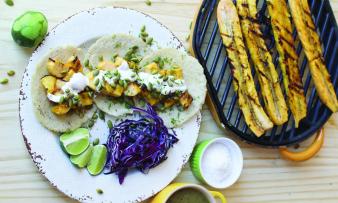
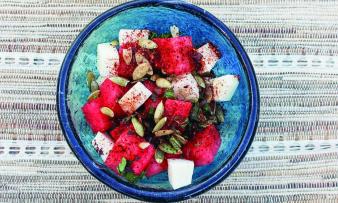





Comments